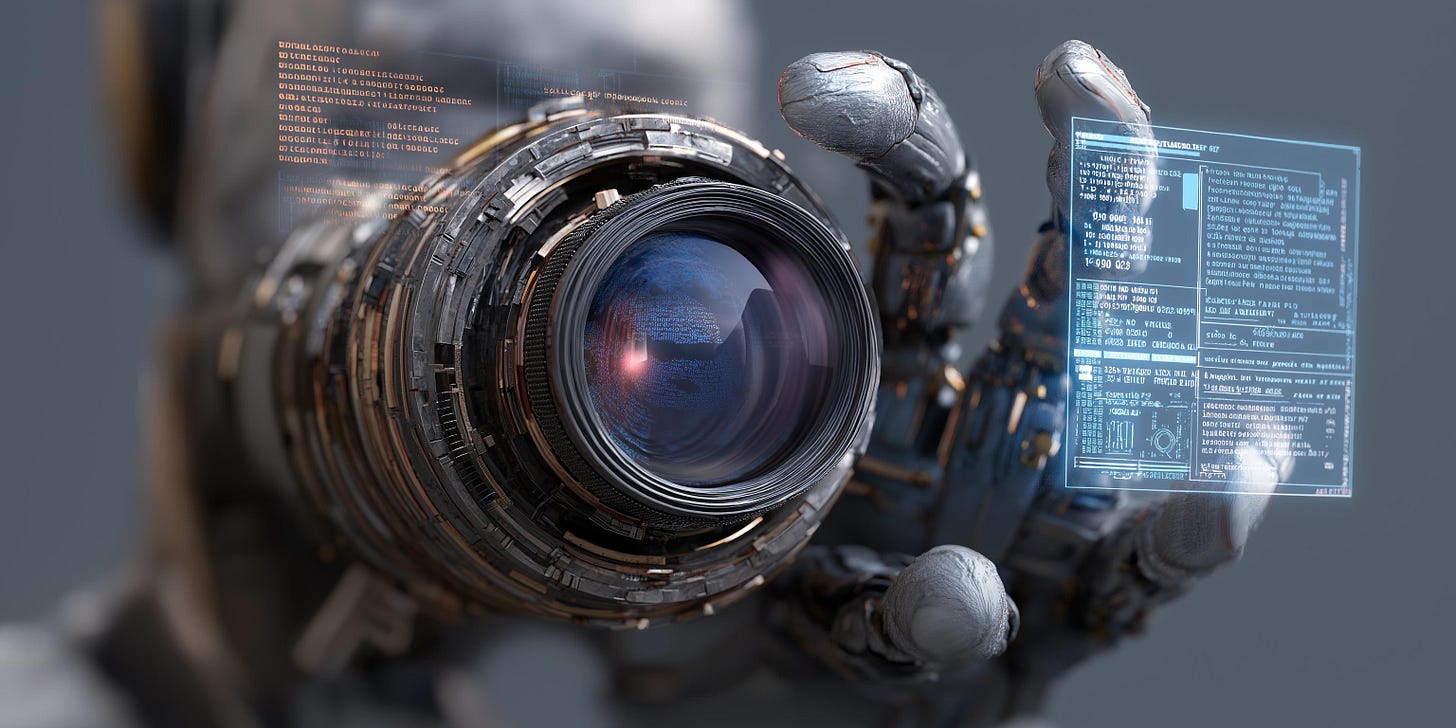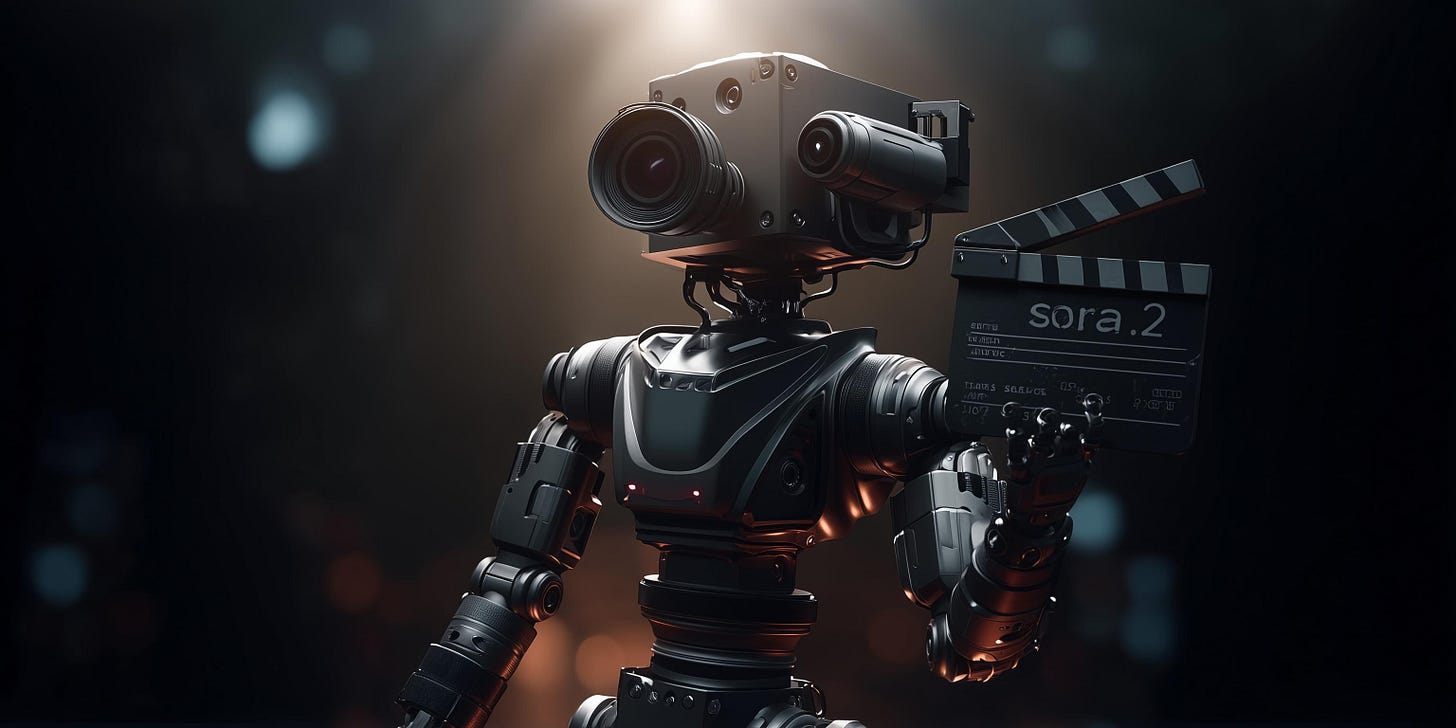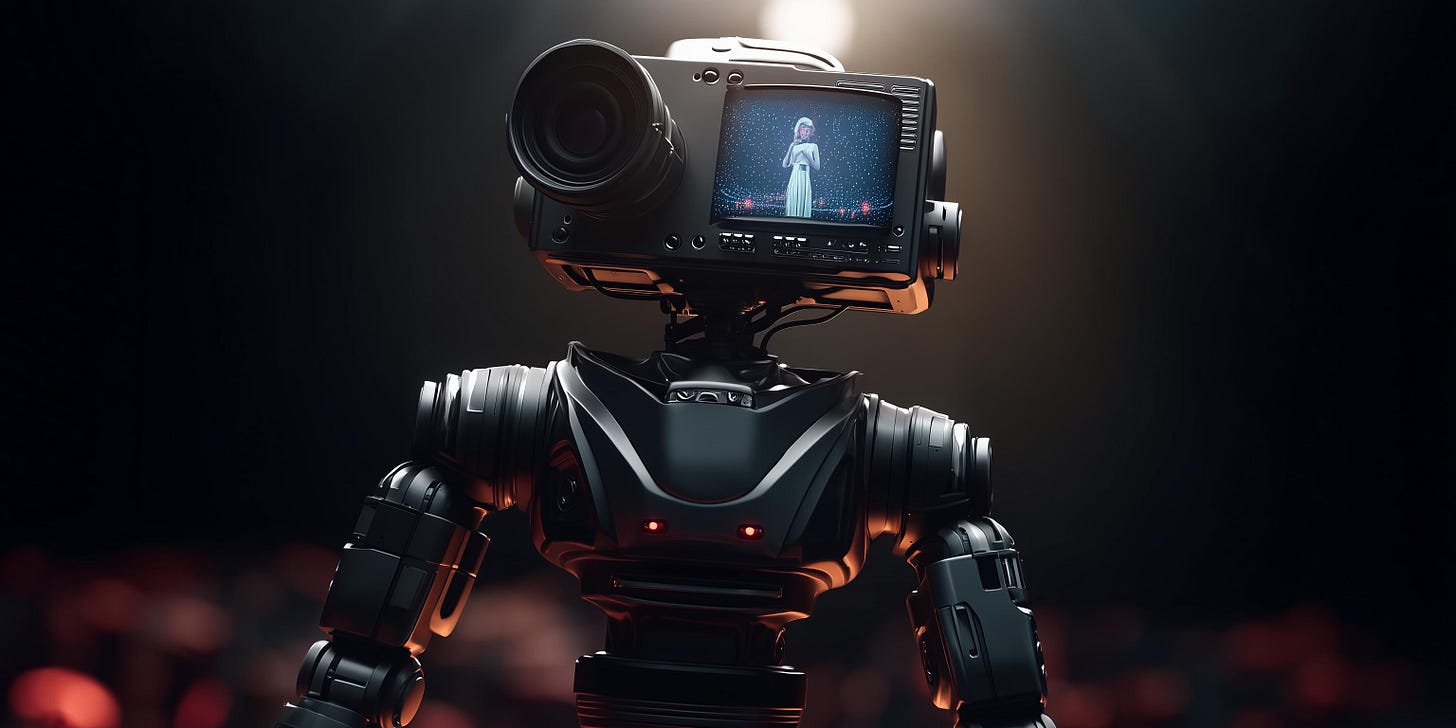Inside the Machine: Fever Mode, Feedback Loops, and Finding Magic
... still wondering if robots have celluloid dreams.
Edited by Elizabeth Kealoha. Pod Digest and Images by Ant Neely.
Your weekly skim of what the Machine Cinema crew debated, discovered, and dropped into the chat.
Too busy to read? Have a listen instead.
If you’d like to become a sponsor, drop into our DMs!
Overheard in “Basecamp”…
Full disclosure, we had our robot friend help us pull all this together and sometimes they are prone to making harmless mistakes.
🎬 Sora 2 Week: APIs, Storyboards, and Longer Clips?
OpenAI’s Dev Day dropped Sora 2 API access, a storyboard-organizer demo, and a flood of invite-code chatter. Best practice takeaways: timestamp your multi-shot prompts, collage multiple refs for consistency, and expect delays under heavy load.
💬 “AI entering fever mode.”
DevDay Playlist | Storyboard demo clip | Krea Sora 2 post | Higgs Veo 3.1 presets
🧩 Conditional Cameo Tags = Shared-World Logic
A clever community experiment: define if/then rules for your cameo persona tied to a hashtag (e.g., #mcwb) so anyone invoking that tag loads the right outfit/traits. Modular identity logic → instant character continuity across creators and series.
Hashtags as unlock keys for shared universes.
Lightweight way to coordinate look/feel at community scale.
Early tests suggest remix persistence across edits.
🎤 Taylor Swift and the AI Perception Problem
Debate over whether Swift used AI in recent scavenger-hunt clips centered less on “did she?” and more on “how we feel when she does.”
Creator brand mediates audience tolerance for AI.
If fans feel “in on it,” pushback softens.
Links to the clips and coverage circulated for context.
💬 “Ai done by people not Taylor Swift ‘slop’… Ai done by Taylor Swift: ‘Wow…tasteful.’”
🏭 Runway in Broadcast Pipelines
A case study on History Channel’s Life After People using Runway circulated, reinforcing AI’s role as a pragmatic post/VFX accelerant—not just a novelty.
“Reference” workflows + editorial curation are carrying a lot of weight.
Broadcast teams can adapt if outputs meet QC realities.
🎞️ Veo 3.1: Announced Everywhere (Except Google)
Partners and platforms teased Veo 3.1 features and presets ahead of any big Google splash. Community consensus: believe the integrators; test when you see it in your queue.
Higgsfield presets live; others (Lovart, Vadoo) signaling support.
Expect rapid preset iteration across hosts.
📈 Who’s Watching? Audience + Adoption Reality Checks
Creators compared view counts and monetization across YT/TikTok, asked for Sora adoption/demographic stats, and shared festival datapoints: Italy’s AI Motion Festival jumped from ~20% AI-generated submissions in 2024 to ~70% (1,000 of 1,400) in 2025—audience size at the festival stayed roughly flat.
Production is exploding; audience growth is spikier and genre-dependent.
“Market testing” with AI is cheap; discoverability is still the boss.
🎛️ New Launches to Watch: Agentic Video + Storyboard→Gen
Two launches got hands-on feedback: an “agentic movie creation” tool Plot Party and Koyal’s storyboard-first flow that only burns credits on final video generation. Early testers flagged beta-grade bugs, but loved the direction.
Unlimited storyboard edits; credits meter only on finals (Koyal).
Agentic pipelines = where a lot of 2025 energy is headed.
🛠️ The Missing Piece: Multi-Artist AI Pipelines
Veteran VFX folks called out the chaos: no shot/asset management equivalent for AI that truly scales across teams. Open-source candidates (ShotBuddy, Heim) and FilmPro’s collab layer surfaced; some run Figma-based alignment and strict prompt schemas as a stopgap.
We need publishers, versioning, and shared prompt libraries across teams.
“Data-management humans” (or agents) may be essential in AI studios.
Expect a “production cloud” for gen-video to appear—fast.
💬 “AI is a mess if you think of it like it’s a mess… build around it.”
🏆 Community Wins & Notes
• MasterChef India promo short (AI-heavy) aired on Sony India—storyboard-then-generate workflow detailed.
• Trailer drop for a fully AI-generated series with a major Turkish producer—global distribution after TV window.
🔗 Link Drop
🧪 Tools & Industry
🎥 Film & Art Projects
📚 Reading & Thought Pieces
Events:
Real Creative “Pick of the Week”
Each week the Machine Cinema members + the Real Creative team obsess over social feeds in search of the world's best AI creative video, gaming, and music projects.
About the project:
This week Timbaland dropped the first music video from his AI artist, TaTa, called “Glitch x Pulse.” The futuristic video features The Jabbawockeez and Timbaland himself, combining rap, beatboxing, and a pop twist inside a Matrix-style world. It’s the debut project from Timberland’s Stage Zero, where AI meets human creativity in what he calls “A-Pop”. The reaction so far has been mixed, with some fascinated by the innovation and others uneasy about where AI fits in music’s future. From Timbaland in Billboard: “The technology of today is perfect for what this is. “What used to take me three months only takes me two days. In the beginning, it was like a toy — it was like going to a toy store. You gotta go through gluttony because you can’t believe that it’s here.”
You can find this and over 300 AI filmmakers and their projects over at realcreative.ai which features some familiar faces from the Machine Cinema community.
Overhead in “We Love Robots”
🧠 AI as a New Medium (Not Just a Tool)
Filmmakers debated whether AI improves cinema or creates a new medium. One member argued that “AI-for-film” thinking is skeuomorphic—trying to fit old workflows into a reality where games, films, and interactive worlds blur together. Others countered that evolution doesn’t mean obsolescence.
“AI will blur media—upload a film, get a game; upload a game, get a film.”
Counterpoint: not every artist wants to migrate mediums; some just want cheaper, faster tools.
Consensus: AI’s impact resembles the Internet or social media revolutions more than NFTs.
💬 “AI is bigger than Napster by an order of magnitude.”
💬 “ChatGPT is already a new medium—it’s interactive storytelling in its purest form.”
Pitchbook analysis on AI VC mania | Logan K. thread: AI as JavaScript layer
🎮 Game Worlds, Not Just Screens
Members discussed the inevitable fusion of film, gaming, and XR—what one called “world exploring.” Someone predicted that by 2027, AI will make game creation so frictionless that “vibe coding” itself will be obsolete.
Expect fully auto-generated 3D worlds from uploaded footage.
“Film” thinking will yield to world-building thinking.
The boundary between storytelling and simulation keeps eroding.
💬 “The thin veneer of technocratic understanding of code is about to vanish.”
Reddit post on 3D world generation
📉 AI Market Fever + The Coming Correction
Economists in the group warned of a looming “AI bubble correction.” Data center overbuild, overvalued chips, and VC FOMO cycles are signs. But even skeptics agreed: the underlying technology isn’t hype—it’s acceleration.
“Exit hurdles become exceptionally large” — Pitchbook
Hardware excess → software optimization wave next.
Expect layoffs before long-term stabilization.
💬 “Every 5–10 years used to be equilibrium… now it’s every 3–6 months.”
Fortune: Data centers and GDP slowdown |TechPolicyPress: NVIDIA’s geopolitical strategy
📚 The NFT Comparison—Dead Analogy Walking
NFTs monetized speculation; AI democratizes creation.
Distribution + production costs dropping simultaneously = paradigm shift.
Expect 2026–27 to mirror early Internet eras, not crypto winters.
💬 “NFTs were Wall Street unbundled; AI is the entire creative economy rewired.”
🌍 Geopolitics of Compute
From Patagonia’s new OpenAI data center to U.S.–China chip policy, AI’s physical footprint became a recurring theme. The thread noted how compute and culture now intertwine—“Silicon is the new steel.”
Artists and technologists must read policy as carefully as code.
Buenos Aires Herald: OpenAI in Patagonia
🎨 Art Meets Algorithm: Interactive Futures
Microdramas = “AI-native participatory cinema.”
💬 “My hope is that this brings interactive storytelling to more creators.”
📰 Distribution Is the New Frontier
A standout resource shared: The Distribution Playbook—a creator-oriented collection on audience strategy in the post-platform era.
The Distribution Playbook
📺 Digital Replicas and Legal Shields
California’s new AI law protecting actors’ digital likenesses sparked conversation on creative rights. The consensus: provenance layers are inevitable, not optional.
Legal protections are evolving faster than union frameworks.
Digital doubles will soon carry metadata passports.
AI Films: California AI laws
🧩 Philosophy Corner: Post-Postmodernism?
A16Z’s essay claiming “the successor to postmodernism is programmable reality” made the rounds. The takeaway: culture may shift from interpreting the world to designing it.
“Those who create the future also predict it.”
Meta prompt for 2026: art as simulation layer.
A16Z: Successor to Postmodernism
🔗 Link Drop
🧪 Tools & Industry
🎥 Film & Art Projects
📚 Reading & Thought Pieces
GenTalks Community Call October 9, 2025
Guests: Monica Monique (Head of Studio & Brand, Secret Level) + Max Balter (Filmmaker & AI Motion Director)
The Conversation
This session convened just days after Sora 2 launched, with Fred opening the floor to reflections on how the platform represents a leap from video generation into participatory cinema. The conversation soon evolved from tool talk to deeper creative process: how artists sustain authenticity, develop professional workflows, and define “real filmmaking” in the AI era.
Monica Monique, founder of Secret Level, traced her path from traditional ad agency creative to running a hybrid AI studio working with global brands. She shared the importance of translating cinematic craft into iterative AI workflows and teaching clients to value process as much as outcome.
Max Balter, a longtime filmmaker straddling VFX, AI, and branded content, expanded on how the filmmaker’s eye remains the differentiator. His focus: consistency, emotional tone, and the discipline of iteration — the qualities that separate AI art from AI filmmaking.
Highlights
The 150-Generation Wall
Fred set up the discussion around the “creative loop” of endless generation.
Monica described it as “the emotional curve of AI filmmaking” — you begin in excitement, descend into fatigue, and eventually hit clarity.
“You have to know when to pivot — but also when to stay in the discomfort long enough to find the magic.”
She noted that iteration is not waste — it’s rehearsal.
Max agreed: “There’s always that moment when one frame out of two hundred is the one you’ve been chasing.”
Monica Monique — The Secret Level Method
Monica outlined her studio’s evolution from a pandemic experiment into a sustainable business built on AI-assisted brand storytelling.
Approach: Treat AI tools as accelerants for pre-production — storyboards, animatics, and mood films that guide live-action or CG shoots.
Client education: “We teach them that AI isn’t a button, it’s a process — the value is in the refinement loop.”
Creative positioning: The studio “sells thinking, not outputs.”
Niching down: She advised artists to specialize: “You can’t be everything — find the corner you want to master.”
Authorship: For Monica, “real filmmaking” is defined by intent, not medium. “If there’s a story, human decision, and emotional arc — that’s film.”
Team model: Secret Level runs on small, cross-disciplinary pods — writers, art directors, and AI operators — emphasizing collaborative iteration and speed.
Max Balter — The Filmmaker’s Eye in the AI Era
Max described how he approaches AI as an extension of the cinematographer’s craft.
Visual continuity: “You have to think in light and lens terms, not prompts. Consistency of camera logic — that’s the new cinematography.”
Process discipline: He keeps “generation logs” — notes on what worked, what broke, and which model produced which look — treating AI like a cinematography lab.
Voice & authenticity: “AI can make pictures. Filmmakers make moments.”
Career balance: He emphasized the need to balance commissioned work with personal pieces that push artistic growth.
Philosophy: “Follow your passion. That’s still the most reliable path to success.”
Evolving the Industry Mindset
Both guests reflected on how traditional filmmaking values still anchor AI creation.
Monica: “Producers are learning that iteration time is creative time — not inefficiency.”
Max: “What used to take months of previs now takes hours, but storytelling instincts matter more than ever.”
Fred highlighted that the conversation itself represented a shift — away from hype toward craftsmanship.
Advice for Emerging AI Filmmakers
Document everything: Proof of human intent is becoming the foundation of authorship.
Specialize, but stay curious: Master one domain while tracking cross-tool workflows.
Iterate with purpose: Save and analyze failed generations; treat them as training data for your own style.
Build creative trust: Whether with clients or collaborators, process transparency is currency.
Stay in dialogue: Both guests stressed that the future of this field will be shaped by open community exchange, not proprietary secrets.
Key Quotes
“You have to know when to pivot — but also when to stay in the discomfort long enough to find the magic.” — Monica Monique
“We teach clients that AI isn’t a button, it’s a process.” — Monica Monique
“Real filmmaking is defined by intent, not medium.” — Monica Monique
“Think in light and lens terms, not prompts — that’s the new cinematography.” — Max Balter
“AI can make pictures. Filmmakers make moments.” — Max Balter
“Follow your passion — that’s still the most reliable path to success.” — Max Balter
Takeaways for Machine Cinema Creators
Iteration is rehearsal. Every generation refines intuition.
Educate your collaborators. Transparency builds creative equity.
Define your niche. Specialization drives both artistry and visibility.
Treat AI like cinematography. Light, lens, and rhythm over novelty.
Archive your process. Your logs are proof of authorship.
Lead with intention. Human story sense remains the creative moat.





